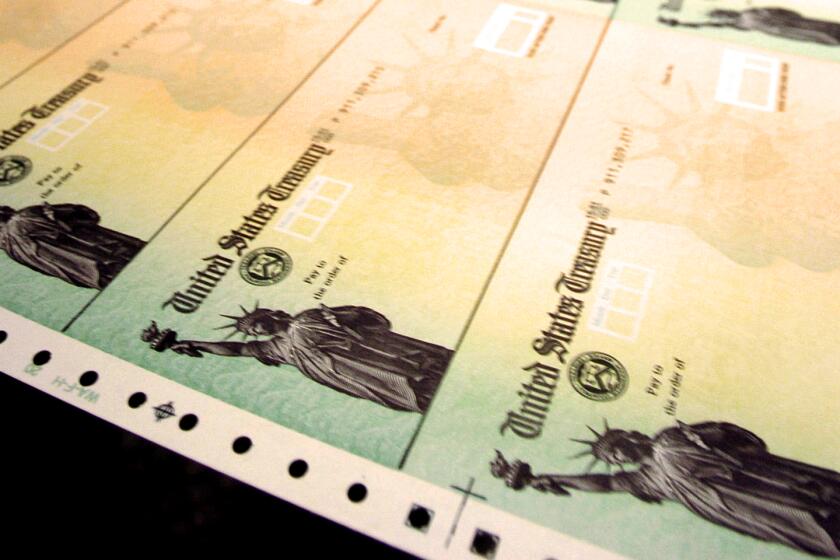The Trouble With Big Wigs : Hairpieces Are Hip, but Production Problems Tangle Supply
- Share via
In the 1960s, they were heavy, hot, unnatural looking and incredibly popular.
But for the wig industry, the late 1970s brought hair-raising disaster as customers, in quest of more natural looks, tossed their wigs and falls in the back of their closets.
Now, it appears, wigs and other hair accessories are gaining favor with a new generation of consumers and sales are springing back like the never-say-die curls of today’s synthetic wig fibers.
“There is a resurgence in the wig industry,” said Josef Scigliano, executive vice president and designer for Los Angeles-based Eva Gabor International, the world’s largest wig company. “It’s really changed. We see a lot of career women coming in to buy wigs.”
Imports Rise
However, there is a snarl. Just as demand for wigs begins to grow, a wig shortage complete with rising prices and shipping delays has developed, some manufacturers contend, that has them tearing out their--well, you get the idea.
At the root of the problem are increasing labor difficulties in South Korea, where most of the wigs sold in the United States are made. But the manufacturer of the synthetic fiber that goes into the majority of wigs thinks that the severity of the shortage may be overstated.
Nonetheless, it comes at a time when the industry could use all the supplies it can get.
From January to July of this year, wigs, toupees, chignons and other hair accessories with an import value of $43.7 million entered the United States, up 19% from the same period last year, according to U.S. Census Bureau statistics. That’s on top of a 23% increase in 1987 from the year before.
Manufacturers credit technological advances in wig structure and a spurt in popularity of hair “add-ons”--ponytails, braids and assorted lengths of synthetic hair attached to clips and combs--which have attracted a younger clientele that has become interested in full wigs.
“It’s only the bad ones you see. The good ones look natural,” said Alan M. Smiley, president of Revlon’s Miami-based General Wig subsidiary. Today’s wigs are much lighter and hold their style better those of the 1960s and early ‘70s.
“I have a demonstration I like to do,” Smiley said. “I take a wig, roll it into a ball, step on it and unroll it. It comes out 99% perfect.
“What good is it for a woman to buy a wig in a wig shop from a stylist if she can’t make it look good at home?”
About 80% of the wigs sold today are made of a synthetic fiber called Kanekalon, produced by Kanegafuchi Chemical Industry of Osaka, Japan, said company spokeswoman B. L. Ochman.
The modacrylic fiber, which is available in 150 colors and different thicknesses and curl patterns, is used in a variety of products from paintbrushes to fake fur coats, she said. The largest use is for hair for Barbie dolls.
“Kanekalon has gotten better and better, and now it looks like human hair,” Ochman said.
Only a relatively small percentage of wigs are made of human hair anymore, and they are much more expensive than synthetic wigs and more difficult to style. A pound of human hair costs $600 in New York while a pound of Kanekalon costs $20, Ochman said.
The wig industry is fairly small, with U.S. retail sales between $300 million and $350 million, Smiley estimated.
Importers Competing
It is dominated by Eva Gabor International and General Wig, with several small importers competing fiercely for the rest of the market. The importers sell to department stores, wig shops and hairdressers. In recent years, buyers primarily have been older women and people who need to wear wigs for medical reasons.
“Until two years ago, the overwhelming majority, better than 90% of the wig sales, were on a need basis rather than a fashion basis,” Smiley said. “The growth that we’re seeing is occurring for fashion.”
When Eva Gabor’s Scigliano--known professionally as Josef of Rome--recently appeared on the Oprah Winfrey Show, callers expressing interest in wigs flooded the switchboard after Winfrey innocently asked if wigs were dead, Scigliano recalled.
He and actress Eva Gabor, who share ownership of the company with Sears, do several fashion shows a year that each draw 2,000 to 3,000 women, he said.
“I don’t know what it is,” Scigliano said. “It’s back in style.”
Scigliano said he is seeing young women at the shows for the first time in years, and manufacturers are responding by creating wigs with a younger, “untamed” look.
“They want a new look” that customers might not be able to get with their own hair if it is too fine or thin, he said. “Now we sell a haircut.”
Eva Gabor International sells about 1.3 million wigs a year with a suggested retail price of $35 to $110. General Wig’s primary line is called Adolfo, which sells for $50 to $110. Neither company reveals sales figures.
All this good news for wig importers and retailers comes mixed with a measure of bad.
“I’m very worried about now,” said Sun Choi, who has owned a Santa Monica store called the Wig Factory for 13 years.
“Many, many Korean factories are closing,” she said. “We order. We wait. There is no shipping.”
Eva Gabor has a two- to three-month order backlog, “which never happened to us before,” Scigliano said.
“Everyone is screaming for delivery,” he said. “The small importer is suffering more than us.”
Industrial Role
The problem has developed in part because of the nature of wig production, a labor-intensive process done primarily by hand. South Korea, the largest exporter of wigs, has tried hard to attract other industries, such as electronics and garment manufacturing, which pay better and are easier than making wigs.
“What Korea wanted was to come out of the dark ages and become an industrial force,” Smiley said. “It paid the price with certain industries, and one of those industries was wigs.”
Korean wig factories have had trouble finding workers and have faced strikes for better wages and working conditions. At least two have closed.
General Wig is in a better position than most companies, Smiley said, because in 1978 it began shifting production to China.
“We were the first to recognize the handwriting on the wall in Korea,” he said. Now, about 70% of General Wig’s production comes from China.
Eva Gabor is working to increase its production in China and other countries but faces enormous initial investments and start-up problems, Scigliano said. In the meantime, the company is flying in much of its inventory rather than shipping it by container, which is eating into profit, he said.
“Other people are trying to get into China now,” Smiley said. “It’s going to be very tough. They’re going to eat a lot of bad merchandise.” General Wig ended up throwing away more than $500,000 worth of wigs during the company’s first three years in China because they did not meet the firm’s quality standards.
But Ochman, spokeswoman for wig fiber maker Kanegafuchi, is doubtful that a wig shortage really exists, pointing to rising import statistics and glowing sales reports from some customers.
“There certainly are problems at the moment in Korea, and those problems have yet to manifest themselves,” she said, adding that there are factories in other countries--China, Thailand and the Philippines, for example--ready to take up the slack.
“It’s a bogus story simply to raise prices to consumers,” Ochman said. “It’s a mom-and-pop industry that is very cut-throat and competitive,” she said. “They compete in any way they can, and this is one of them.”
Ochman worried that talk of a shortage will become “a self-fulfilling prophecy.”
“About 20 years ago, there was the rumor that there was a toilet paper shortage, and you could go to the stores and the shelves were bare” as fearful shoppers stocked up, she said.
Michael Mahoney, executive director of the American Hair Loss Council, a nonprofit information clearing house for people with hair-loss problems, said he has not seen any serious shortage yet.
“There are still plenty around,” Mahoney said. “If I were opening a wig shop there might be some slowdown in getting a complete inventory.”
Real Enough Problem
Mahoney said any shortage would have more of an effect on the fashion side of the industry rather than on people who need wigs for medical reasons and therefore buy custom wigs if possible.
“Many times they avoid the department stores because of the level of privacy, plus they’re saying this is something I have to do so I’m going to get something especially for me,” he said.
The problem is real enough to wig store owner Sun Choi.
Choi already has had to deal with price increases brought about by the weak dollar. But this summer one smaller importer recently passed along a roughly 50% price increase, blaming it on the Korean labor situation.
“It’s so expensive,” she said. “Where customers would buy two wigs, now they buy one.”
Scigliano and Smiley said they must pass on some of the price increases they receive from manufacturers but are trying to keep a lid on the hikes.
“We’re looking at this very carefully,” Scigliano said. “We don’t want to ruin the industry.”
“It’s an interesting combination--increased demand coupled with less and less production,” Smiley said. “I believe it probably will get worse because there is a significant increase in interest in wigs.”
More to Read
Inside the business of entertainment
The Wide Shot brings you news, analysis and insights on everything from streaming wars to production — and what it all means for the future.
You may occasionally receive promotional content from the Los Angeles Times.










